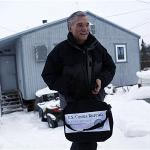
This is IN THE NEWS in VOA Special English.
Census forms have been mailed across America. Every ten years since 1790 the Constitution has required a population count.
The results decide how many seats each state will have in the House of Representatives. The numbers will also decide how more than 400 billion dollars a year in federal assistance is divided.
States that are hurting financially depend on the federal government for about 20 percent of their money. The more people counted, the more money the states can receive.
But counting the world's third largest population -- about 309 million by current estimates -- is no easy job. The process costs more than 14 billion dollars.
The Census Bureau says the ten-question form this year is one of the shortest ever and should take no more than ten minutes. Officials want all forms returned by Census Day, April 1st.
The form asks for the number of people living or staying in a house, apartment or mobile home. It asks for the name of each person living there, and about the ownership of the home. There are also race and ethnicity questions. And a phone number is requested, the form explains, in case an answer is not understood.
The records are made public after 72 years. But until then, federal law bars the Census Bureau from sharing individual records with any other agency -- such as immigration or anti-terrorism officials.
Leaders of minority groups including Hispanics and Muslims are urging their communities to complete the form so they are counted. But some people say they do not trust the government and will not answer all the questions.
People are required by law to answer all questions to the best of their ability. There is a 500 dollar fine for giving false answers. There is a fine of up to 5,000 dollars for not returning a census form, but the fine is rarely enforced.
Officials say about 70 percent of the population took part in the last census. This year they hope for higher rates. Still, they expect more than 47 million households not to return their forms. This will require a visit by a census worker.
This year's mailing includes, for the first time, bilingual forms in English and Spanish. The Census Bureau chose 13 million households in areas with large numbers of Spanish speakers. In addition, forms will be available in 59 languages including Chinese, Korean and Russian.
Within around 30 years the Census Bureau expects racial and ethnic minorities to form the majority of America's population. But more than half of all children will be minorities in less than half that time. Minority children, especially Hispanics, are increasing at a fast rate while the United States has fewer white children. Experts predict that the share of babies born to white, non-Hispanic women will fall below 50 percent within the next two years.
And that's IN THE NEWS in VOA Special English, written by Brianna Blake. For more news, go to voaspecialenglish.com. I'm Steve Ember.
In LA, homelessness declines despite economic crisis
Sometimes the "good life" needs an anchor
(来源:VOA 编辑:陈丹妮)
